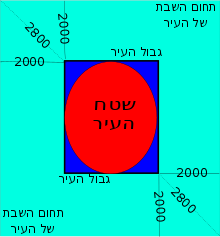Techum shabbat
In Jewish halacha, the techum shabbat (Hebrew: תחום שבת, "Shabbat boundary"), or simply techum, is a limited physical area in which a Jew is permitted to walk on foot on Shabbat and Jewish holidays. In general, this area is calculated by measuring 2000 cubits (about 1 kilometer) in every direction from the place (or settlement) where a person was located when Shabbat began.
Sources
The source of the prohibition is the verse in Exodus in which Moses commands the Israelites not to leave their encampment to gather manna on Shabbat:
- "Behold, the Lord has given you the sabbath, therefore He gives you on the sixth day bread for two days; each man shall stay put, and not leave his place on the seventh day." (Exodus 16:29)
According to the Babylonian Talmud, the current prohibition is of rabbinic origin, and this verse is only a asmachta (hint) to a rabbinic law, rather than the source of a Biblical law. However, the Jerusalem Talmud states that while the prohibition to venture further than 2000 cubits (one mil) is rabbinic, venturing a distance over 12 mil is Biblically forbidden. Maimonides rules according to the Jerusalem Talmud,[1] while others rule according to the Babylonian Talmud.[2]
The starting point for measurement
A person who is located in an open area outside human settlement, measures 2000 cubits outside the "four cubits" surrounding him which are considered his personal space.[3] If a person is located in an isolated house which is not part of a larger settlement, the techum is measured from outside the courtyard of his house. If he is within a settlement, the entire area of the settlement is considered his personal space.[4][5]
A person need not say or intend anything particular for this normal techum to take effect.[6] However, he may declare that his "dwelling place" is located in a different place from his location at the entrance of Shabbat (on condition that the place he is physically located is within the techum for the place he has declared). For example: if a person is located just outside a city, he may declare that his dwelling place is within the city.
When this declaration is made in error, it is not valid.[7] Therefore, a person who does not realize before Shabbat that he is adjacent to a city, and discovers this fact during Shabbat, may then enter the city and calculate his techum according to the city's techum. However, if he was aware of the city before Shabbat and knowingly chose his "dwelling place" to be based on his location outside the city, his techum remains as he intended, and if parts of the city are outside his 2000-cubit zone, he may not enter those parts.[8]
Determining the city boundary

To calculate the techum for a city, it is first necessary to determine the city boundary from which the 2000 cubits are to be measured. A city may be of any shape, but the boundary used for this purpose is always a rectangle - the smallest rectangle which can contain the entire city. The measurement of 2000 cubits for a city's techum begins at the edge of this rectangle.
Any house which is found within a distance of 70 cubits (~35 meters) from the city is considered part of the city. If a second house is located less than 70 cubits from the first house, then it too is considered part of the city. By this principle, a "city" can extend over a large area even if its buildings are quite distant from one another. This is on condition that the buildings are used for dwelling, not for storage or other purposes.[9] Of course, the rectangle enclosing the city will include even more space.
Two cities which have less than 141 cubits of open space between them are considered to be one city for the purposes of calculating techum.
When a group of nomadic people live in temporary buildings such as tents, their encampment is not considered a single settlement, and each individual measures 2000 cubits from his own dwelling. But if they built a fixed common structure such as a fence, they do count as a single settlement.[10]
References
- ↑ Mishneh Torah, Shabbat, 27
- ↑ Aruch HaShulchan, Orach Chaim, 397:2
- ↑ Aruch Hashulchan, Orach Haim 398:1
- ↑ Aruch Hashulchan, Orach Haim 398:1
- ↑ Aruch Hashulchan, Orach Haim 398:3
- ↑ Aruch Hashulchan, Orach Haim 400:1
- ↑ Aruch Hashulchan, Orach Haim 400:1
- ↑ Aruch Hashulchan, Orach Haim 400:2
- ↑ Aruch HaShulchan Orach Haim 398:14
- ↑ Aruch Hashulchan, Orach Haim 398:22